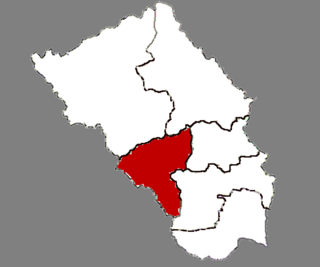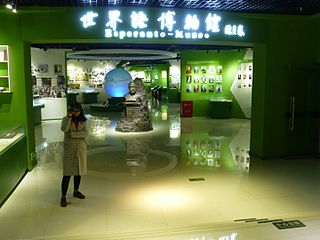You can help expand this article with text translated from the corresponding article in Esperanto. Click [show] for important translation instructions.
|
![Esperanto Museum [de; eo] in Zaozhuang University Musee Esperanto Zaozhuang Chine.jpg](http://upload.wikimedia.org/wikipedia/commons/thumb/0/0d/Mus%C3%A9e_Esperanto_Zaozhuang_Chine.jpg/220px-Mus%C3%A9e_Esperanto_Zaozhuang_Chine.jpg)
Esperanto in China dates back to the late Qing dynasty, and remains active in China.
You can help expand this article with text translated from the corresponding article in Esperanto. Click [show] for important translation instructions.
|
![Esperanto Museum [de; eo] in Zaozhuang University Musee Esperanto Zaozhuang Chine.jpg](http://upload.wikimedia.org/wikipedia/commons/thumb/0/0d/Mus%C3%A9e_Esperanto_Zaozhuang_Chine.jpg/220px-Mus%C3%A9e_Esperanto_Zaozhuang_Chine.jpg)
Esperanto in China dates back to the late Qing dynasty, and remains active in China.
Esperanto was imported to the Qing dynasty along with other western inventions, and mainly from Russian merchants in Harbin. It was brought from Chinese students who studied overseas, in Japan, France, and Britain. The first attested Esperanto courses in China were held in Shanghai in 1906. Shanghai later became the birthplace of the Chinese Esperanto Association in 1909. The association was active during the Xinhai revolution, with the education minister of the Republic of China, Cai Yuanpei, ordering Esperanto to be taught in Chinese schools as an elective course. Cai later invited Vasili Eroshenko to be an esperanto instructor at Beijing University. In 1923 the Beijing Esperanto College was founded. Esperanto also played a pivotal role in national liberation movements in China during the Sino-Japanese war of 1937, with the slogan per Esperanto por la liberigo de Cinio (transl. the liberation of China through Esperanto). The Esperanto movement was also popular among Chinese anarchists such as Ba Jin, Li Shizeng, and Liu Shifu. After the PRC takeover, the China Esperanto League was founded in 1951, but the support of the communist government initially waned. The first ever national Esperanto meeting was held in 1963. This led to a lot of Esperanto courses being opened in 1964. The movement faced another challenge during the cultural revolution due to the arrest of esperantists. [1] [2]
The peak amount of Esperanto learning in China occurred in the 1980s, but its prominence decreased as emphasis on teaching English in China increased. [3]
In 2018, Zaozhuang University began allowing students to major in Esperanto. [4] In 2023, in all of China, only Zaozhuang University still had a department dedicated to teaching Esperanto. In January 2023, that department had 24 students. That enrollment decreased after a social media influencer mocked the program the following month. [3]
People's Republic of China publishes its official magazine El Popola Ĉinio, which began its publication in 1950. [2] [1]
In 2012, a museum to Esperanto (Esperanto Museum ) was established at Zaozhuang University. [4]

China, officially the People's Republic of China (PRC), is a country in East Asia. With a population exceeding 1.4 billion, it is the world's second-most populous country. China spans the equivalent of five time zones and borders fourteen countries by land. With an area of nearly 9.6 million square kilometers (3,700,000 sq mi), it is the third-largest country by total land area. The country is divided into 33 province-level divisions, inclusive of 22 provinces, five autonomous regions, four municipalities, and two semi-autonomous special administrative regions. Beijing is the national capital, while Shanghai is its most populous city and largest financial center.

Peking University (PKU) is a public university in Haidian, Beijing, China. It is affiliated with and funded by the Ministry of Education of China. The university is part of Project 211, Project 985, the Double First-Class Construction, and the C9 League.

Cheongsam or zansae, also known as the qipao and sometimes referred to as the mandarin gown, is a Chinese dress worn by women which takes inspiration from the qizhuang, the ethnic clothing of the Manchu people. The cheongsam is most often seen as a longer, figure-fitting, one piece garment with a standing collar, an asymmetric, left-over-right opening and two side slits, and embellished with Chinese frog fasteners on the lapel and the collar. It was developed in the 1920s and evolved in shapes and design over years. It was popular in China from the 1920s to 1960s, overlapping with the Republican era, and was popularized by Chinese socialites and high society women in Shanghai. Although the cheongsam is sometimes seen as traditional Chinese clothing, the cheongsam continues to evolve with times as it responds to the contemporary modern life.

Nanyang is a prefecture-level city in the southwest of Henan province, China. The city with the largest administrative area in Henan, Nanyang borders Xinyang to the southeast, Zhumadian to the east, Pingdingshan to the northeast, Luoyang to the north, Sanmenxia to the northwest, the province of Shaanxi to the west, and the province of Hubei to the south.

Beijing Normal University (BNU) is a public university in Beijing, China. It is affiliated with the Ministry of Education of China, and co-funded by the Ministry of Education and the Beijing Municipal People's Government. The university is part of Project 211, Project 985, and the Double First-Class Construction.

Beijing Foreign Studies University is a public university in Haidian, Beijing, China. It is affiliated with the Ministry of Education. The university is part of Project 211 and the Double First-Class Construction.

The Korean independence movement was a series of diplomatic and militant efforts to liberate Korea from Japanese rule. The movement began around the late 19th or early 20th century, and ended with the surrender of Japan in 1945. As independence activism on the peninsula was largely suppressed by Japan, many significant efforts were conducted abroad by the Korean diaspora, as well as by a number of sympathetic non-Koreans.
Anarchism in China was a strong intellectual force in the reform and revolutionary movements in the early 20th century. In the years before and just after the overthrow of the Qing dynasty Chinese anarchists insisted that a true revolution could not be political, replacing one government with another, but had to overthrow traditional culture and create new social practices, especially in the family. "Anarchism" was translated into Chinese as 無政府主義 literally, "the doctrine of no government."
The city of Beijing has a long and rich history that dates back over 3,000 years.

Tai'erzhuang District is the southernmost of five districts under the administration of the prefecture-level city of Zaozhuang. The district is located in the south of Shandong Province, China, bordering Jiangsu province to the south. It covers an area of 538 km2 (208 sq mi) and has a population of 290,000.According to the seventh population census data, as of 0:00 on November 1, 2020, the permanent population of Taierzhuang District was 305102.

Yicheng District is a district of Zaozhuang, Shandong, China. It has an area of 627.6 square kilometres (242.3 sq mi) and around 360,200 inhabitants. (2003)As of the end of 2022, the total household population of Yicheng District was 417,086,000 people.

Xuecheng is a district and the seat of Zaozhuang, Shandong province, China, ever named by "lin cheng ". It has an area of 506.72 km2 and around 405,285 inhabitants (2003). As of the end of 2022, the resident population of Xuecheng District was 485,637.As of May 2022, Xuecheng District has five streets and four towns under its jurisdiction, with the district government stationed at No. 2 Yongfu Middle Road.Xuecheng is the hometown of national suona, national paper-cutting hometown, national martial arts hometown, national advanced district of mass culture, the birthplace of Shandong Express Scripts, the hometown of Xi Zhong, the originator of car-making, and the hometown of railroad guerrillas.

The Suzhou High School of Jiangsu Province (江苏省苏州中学) is a public high school in Suzhou, Jiangsu, China.
Shanghai Rubber Stock Market Crisis was an economic crisis caused by the bankers and stock-holders overstimulating the rubber stocks in Shanghai in 1910. This crisis led to a great number of bankruptcies of Chinese native banks in Tianjing, Guangzhou, etc. Historically, this crisis, accomplished with the market crisis in the 1920s, brought massive destruction of market development in Shanghai.

Nanjing University (NJU) is a public university in Nanjing, Jiangsu, China. It is affiliated and sponsored by the Ministry of Education. The university is part of Project 211, Project 985, and the Double First-Class Construction. The university is a member of the C9 League.

Xiang Jingyu, was one of the earliest female members of the Chinese Communist Party (CCP), widely regarded as a pioneer of the women's movement of China.

Shanghai Jiao Tong University (SJTU) is a public university in Shanghai, China. It is affiliated with the Ministry of Education of China. The university is part of Project 211, Project 985, and the Double First-Class Construction.
Cai Shaoqing was a Chinese historian and professor at Nanjing University, considered a leading authority on the history of Chinese secret societies. He pioneered the research of Tiandihui and other secret societies using Qing dynasty archives and overturned the findings of earlier Republican-era scholars. He also studied the links between the Warlord Era and banditry during the late Qing dynasty and early Republic of China. He received the Frederic Milton Thrasher Award for his research on Chinese secret societies.
Cai Haoyu is a Chinese businessman, investor, and video game producer. He is best known as the co-founder and CEO of The miHoYo Group, a Chinese game company. The Chinese magazine New Fortune ranked Cai in 73rd place on the "2022 New Fortune 500 Rich List" that ranks the 500 richest people in China.

Zaozhuang University is a post-secondary educational institution in Zaozhuang, Shandong, China.